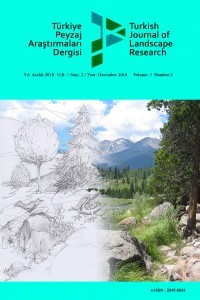Sürdürülebilir Kent Modeli Olarak, Eko-Kent Önerisi
Eko-kent, doğal ekosistemlerin kendi kendine yeten esnek yapısı ve işlevi üzerine modellenmiş bir insan yerleşmesidir. Mevcut kentleri yapımı ve daha ekolojik temelli ve yaşanabilir yeni kentsel gelişim için sürdürülebilirlik konusunda küresel baskının oluşması acil bir önceliktir. Son zamanlarda, kendi tükettiği enerjilerini üreten ve doğaya saygı duyan kentler yaratmak için eko-kent kavramı ortaya çıkmıştır. Eko-kent kavramı, kent ve çevre ilişkisinin ve etkileşiminin tartışıldığı kentsel tasarım ve uygulama yaklaşımıdır. Eko kent tasarımları; yenilenebilir enerji kaynaklarının kullanımı, minimum atık üretimi, geri dönüşüm malzeme kullanımı, biyolojik çeşitliliğin korunması, karbon ayak izinin en aza indirilmesi, hava kirliliğinin önlenmesi, kentsel ısı adası oluşumunun önlenmesi ve kentin çevre üzerindeki etkisinin azaltılması gibi sürdürülebilir ilkeleri ele almaktadır. Bu yaklaşımla ekosistemin işlevleri sağlıklı bir şekilde sürdürülebilecek ve insanların yaşam kalitesi iyileştirilecektir. Bazı yerel yönetimler ve şehir sakinleri eko-kent kavramını benimsemelerine rağmen kentsel nüfus artışı nedeniyle, eko kent uygulaması, uygulama sürecinin maliyeti ve kurumlar ile kuruluşlar arasındaki iletişim ve işbirliği eksikliği nedeniyle askıya alınmıştır. Artan nüfusla birlikte, hızla büyüyen kentlerin çevresel sorunlarının gelecekte daha ciddi ve potansiyel olarak yıkıcı etkileri olacaktır. Bu nedenle, çok geç olmadan, eko-kent ilkeleri, hedeflenen eko-kentsel tasarımların gerçekleştirilmesi için bir gereklilik olarak kabul edilmelidir.
Anahtar Kelimeler:
Eko-kent, Sürdürülebilir Kentler, Kentleşme, Kentsel Tasarım, çevre ve doğa
The Eco-City Proposal As A Sustainable City Model
An Ecocity is a human settlement modeled on the self-sustaining resilient structure and function of natural ecosystems. The ecocity approach is an effort to change the nature of cities to make them more ecologically sustainable. Making existing cities and new urban development more ecologically based and liveable is an urgent priority in the global push for sustainability. Recently, the concept of eco-city has emerged in order to create cities that produce their own energy and respect the nature. The concept of eco-city is the urban design and application approach in which the relation and interaction of city and the environment are discussed. Eco city designs; Sustainable principles such as the use of renewable energy resources, minimum waste generation, recycling material use, biodiversity conservation, minimizing carbon footprint, preventing air pollution, preventing the formation of an urban heat island and reducing the impact of the city on the environment are taken into account. With this approach, the functions of the ecosystem can be maintained in a healthy way and the quality of life of the people will be improved. Although some local administrations and city dwellers adopt the concept of eco-city because of the population of millions of present-day cities, the implementation process is suspended due to the cost of the implementation process and the lack of communication and cooperation between institutions and organizations. With the increasing population, the environmental problems of the rapidly growing cities will have more serious and potentially devastating effects in the future. Therefore, before it is too late, eco-city principles should be accepted as a necessity in order to achieve targeted eco-urban designs.
Keywords:
Eco-city, Sustainable City, Urbanization, Urban Design, Environment and Nature,
___
- Aksan, C. E. (2017, Nisan 22). https://yoldanciktim.com/permakultur-tasarimi/ adresinden alındı Boeri, S. (2015). (Stefano Boeri Architetti) 2019 tarihinde https://www.stefanoboeriarchitetti.net/en/project/liuzhou-forest-city/ adresinden alındı Eagle Street Rooftop Farm. (tarih yok). https://rooftopfarms.org/ adresinden alındı Ergin, E. (2014, Eylül 22). 2019 tarihinde http://www.bilimgenc.tubitak.gov.tr/makale/biyocesitlilik-ve-koruma-biyolojisi adresinden alındı Engwicht, D., & David, E. (1992). Towards an eco-city: calming the traffic (Vol. 18). Sydney: Envirobook. Ezer, B. (2016, Haziran 10). 2019 tarihinde http://www.artfulliving.com.tr/kultur-ve-yasam/asklepiostan-miras-sifa-kulturu-i-6543 adresinden alındı Gaffron, P., Huismans, G., Skala, F., Messerschmidt, R., Verdaguer, C., & Koren, C. (2005). Ecocity. Book I. Facultas Verlags-und Buchhandels AG. İnsan Hakları Eğitimi İçin Halklar Hareketi. (2013). 2019 tarihinde http://pdhre.org/rights/education.html adresinden alındı Joss, S., & Molella, A. P. (2013). The eco-city as urban technology: Perspectives on Caofeidian international eco-city (China). Journal of Urban Technology, 20(1), 115-137. Kavcar, B. (2017). http://sbpturkiye.com/eko-kent-modeli.html adresinden alındı Martin, E., & Beatley, T. (1993). Our Relationship with the Earth: Environmental Ethics in Planning Education. içinde Özdemir, Z., Aslan, S., & Kaplan, H. (2017). Implementation Issue of "Eco-city" Projects in Turkiye: An Assessment of Problems Encountered. In International Sustainable Buildings Symposium (pp. 584-614). Springer, Cham. Pickett, K., & Wilkinson, R. (2009). The Spirit Level: Why Greater Equality Makes Societies Stronger. içinde New York: Allen Lane. Pimental, D., Westra, L., & Noss, R. (2000). Ecological Integrity: Integrating Environment, Conservation, and Health. içinde Washington DC. Raworth, K. (2013). State of the World 2013: Is Sustainability Still Possible? A Worldwatch Institute report. içinde Washington DC. Redefining Progress. 2013. Sustainability Indicators: Genuine Progress Indicator. Online resource (http://rprogress.org/sustainability_indicators/genuine_progress_indicator.htm) Register, R. (2012). https://ecocitystandards.org/standards/ adresinden alındı Register, R. (1987). Ecocity Berkeley: building cities for a healthy future. North Atlantic Books. Roseland, M. (1997). Dimensions of the eco-city. Cities, 14(4), 197-202. T.C Çevre ve Şehircilik Bakanlığı. (tarih yok). Temiz Hava Hakkı Platformu. (tarih yok). https://www.temizhavahakki.com/wp-content/uploads/2019/04/Hava-Kirlili%C4%9Fi-Ve-Sa%C4%9Fl%C4%B1k-Etkileri.pdf adresinden alındı Tezel, T. (2016, Ekim 16). https://www.yasamicingida.com/gida/saglikli-temiz-gidaya-erisim-temel-insan-hakkidir/ adresinden alındı The Sustainable City. (2015). 2019 tarihinde https://www.thesustainablecity.ae/ adresinden alındı Türküm. (2013). Meydan (s. 172). içinde United Nations Intergovernmental Climate Panel. (2010). 2019 tarihinde alındı Wong, T. C., & Yuen, B. (2011). Eco-City Planning. Policies, practice and design: Springer Science+ Business Media BV. Yu, L. (2014). Low carbon eco-city: New approach for Chinese urbanisation. Habitat International, 44, 102-110. URL-1. (2018). http://ekolojist.net/yesil-bina-nedir-standartlari-nelerdir/ adresinden alındı URL-2. (tarih yok). (SEMTRIO) 2019 tarihinde https://www.semtrio.com/image/data/Leed-Sertifikasi/leed-kriterleri.png adresinden alındı URL-3. (2016). 2018 tarihinde http://www.ateliercitoyen.org/index.php/2016/03/02/cahier-transport/ adresinden alındı URL-4. (tarih yok). 2018 tarihinde http://www.tverlesproekt.ru/lesopatologicheskoe-obsledovanie/ adresinden alındı
- ISSN: 2645-8942
- Başlangıç: 2018
- Yayıncı: Ömer Kamil ÖRÜCÜ
Sayıdaki Diğer Makaleler
Sürdürülebilir Kent Modeli Olarak, Eko-Kent Önerisi
İsmet AKINCI, Sima POUYA, Bülent YILMAZ
Bölgesel Ölçekli Peyzaj Envanteri ve İzleme için Bir Araç Olarak Arazi Örtüsü Haritalama
Hakan ALPHAN, Mehmet Ali DERSE
Güler Ufuk DEMİRBAŞ, Özgen Osman DEMİRBAŞ
Ankara'nın Kaybolan Doğal ve Kültürel Değerleri
Büyük Ölçekli Peyzaj Alanlarındaki Sulama Sistemlerinin İncelenmesi: Çanakkale Örneği
